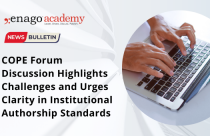Instructions to Authors – for Beginners (Part 1)

Most journals list the scope and audience of the journal on their homepage itself, and that’s the page most authors visit when first perusing a journal. However, authors must thoroughly go through the “Instructions to Authors” page before finalizing the journal and also before starting to write the manuscript. Here’s why:
“The Journal reserves the right to reject manuscripts that do not adhere to the instructions to authors.”
This is a statement that you will find on most journals’ author instructions pages. That is, manuscripts that do not conform to the journal’s standards are usually returned to the author for amendment before proceeding to any other stage.
Journal editors have developed these instructions in order to process manuscripts easily and in a timely fashion. Publishers have certain fixed criteria for the type, length, format, and style of manuscripts to be accepted, and adhering to these instructions avoids unnecessary delays in the publication cycle.
Instructions to authors basically cover three important aspects of the publication process that are important for every author:
- Journal’s purpose, scope, and policies
- Manuscript preparation guidelines
- Manuscript submission process
This series discusses all the three aspects in detail.
How to Find Instructions to Authors?
Where to find the guidelines on the journal’s page? Most “Instructions to Authors” pages are either one or two links away from the journal’s homepage. They sometimes fall under the following headings:
- Resources for Authors
- For Authors and Referees
- Information for Contributors
- Formatting Guide to Authors
- Guide for Authors
- Submission Guidelines
- Author Guidelines
Basically, they cover the same content and usually have the words “author” or “guidelines” in them.
The following link provides instructions to authors for over 3,500 journals in the health and life sciences: http://mulford.utoledo.edu/instr/. All links are to “primary sources,” i.e., to publishers and organizations with editorial responsibilities for the titles. All you need to know is the journal name or some words in it.
Journal’s Purpose and Policies
Every author who wishes to submit his paper to a journal must adhere to the policies and guidelines of the target journal:
Purpose
Instructions to authors begin with stating the purpose of the publication. The purpose usually talks about the subject area, type of research, and the intended audience. For example:
Mission Statement of Physical Review Letters
Physical Review Letters, published by the American Physical Society, is charged with providing rapid publication of short reports of important fundamental research in all fields of physics. The journal should provide its diverse readership with coverage of major advances in all aspects of physics and of developments with significant consequences across subdisciplines. Letters should therefore be of broad interest.
From this, we understand the below points for Physical Review Letters:
- Type of article: Letters
- Publication cycle: Rapid
- Subject area: All fields of Physics
- Type of research: Reports on substantial advances in the field of physics
- Readership: Diverse readership, Broad-interest topics
Tip 1!
Read every word in the statement of purpose carefully and match it to your own purpose to select a journal
Type of Article
Editorials, Original Articles, Review Articles, Letters, etc., are the various different types of articles that one can submit to most journals. Some journals, like the New England Journal of Medicine publish more than 20 different types of articles.
Here are some common types of articles:
- Abstract: The article itself is an abstract of a paper or presentation that has been presented or published separately.
- Book Review: Review or analysis of one or more printed or electronic books.
- Brief Report: A short and/or rapid announcement of research results.
- Case Report: Case study, case report, or other description of a case.
- Commentary: The article has another article or articles as its subject or focus; this article comments on the other article(s). For example, for a controversial article, the editors of the publication might invite the author of an opposing opinion to comment on the first article and publish the two together.
- Editorial: Opinion piece, policy statement, or general commentary, typically written by staff of the publication.
- Letter: Letter to the publication or to its editors, typically commenting upon a published item.
- News: News item, typically labeled “News.”
- Research/Original Article: Research article, usually describing original research.
- Review Article: Review or state-of-the-art summary article.
Tip 2!
Read the descriptions for article types and match them with your own purpose and research methodology
Authorship Criteria
Multiple authors are usually involved in writing a paper, and it is the responsibility of every person listed as the author of an article to have contributed in a meaningful and identifiable way to the design, performance, analysis, and reporting of the work. However, most journals don’t ask that the specific contributions of individual authors be reported. Instead, one author called the “corresponding author” is appointed by the authors themselves to be responsible for the manuscript as it moves through the journal’s submission process.
Tip 3!
The author with the most strong English and communication skills should be designated as the corresponding author because he in-charge of all correspondence with the journal.
Peer Review
Typically, the first stage for a newly submitted article is that the editorial staff has to consider whether to send it for peer review. Once the decision has been made to peer review the paper, the choice of referees is made by the editor who has been assigned the manuscript. Most papers are sent to two or three referees, but some are sent to more or, occasionally, just to one.
Referees are chosen for the following reasons:
- independence from the authors and their institutions
- ability to evaluate the technical aspects of the paper fully and fairly
- currently or recently assessing related submissions
Some journals like Physical Review Letters encourage authors to submit a list of scientists who they believe are especially suited to referee their papers. Particularly if the paper addresses a particularly arcane or controversial subject or view. Of course, the editor is not obliged to select a name from that list.
Tip 4!
An author should be well versed with the journals peer review process and agree to the review methodology before submission to avoid conflicts later.
Language and Technical Editing
A number of journals, especially those with a high impact factor, also have it in their policy that papers should be edited for accuracy and clarity before publication. While some simply recommend a list of editing companies that can do this job, some, like Nature, have their own team of subeditors to ensure maximum clarity and reach.
The process of editing enhances the value of papers in various ways:
- it ensures maximum clarity and precision
- it ensures that the manuscript length is correct (including figures)
- it ensures that the terminology and notation conform to the Journal’s in-house style
Tip 5!
Especially non-native authors should submit their manuscript for editing to be eligible for publication in international journals.
Now that we are familiar with the procedures and policies of a journal, in our next issue, we will talk about Tips for Manuscript Preparation.










